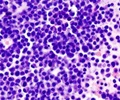Blocking a protein normally credited with suppressing leukemia may be a promising therapeutic strategy for an aggressive form of the disease called acute myeloid leukemia (AML), suggests research.

The protein scientists targeted is a transcription factor known as RUNX1, which also plays an important role in helping regulate the normal development of blood cells. The researchers were surprised to discover in their laboratory tests that RUNX1 was supporting the growth of AML fueled by what are called fusion proteins.
"RUNX1 is generally considered a tumor suppressor in myeloid neoplasms, but our study found that inhibiting its activity rather than enhancing it could be a promising therapeutic strategy for AMLs driven by fusion proteins," said James Mulloy PhD., a researcher in the Division of Experimental Hematology and Cancer Biology at Cincinnati Children's and lead investigator.
AML develops and progresses rapidly in patients, requiring prompt treatment with chemotherapy, radiation or bone marrow transplant. These treatments can be risky or only partially effective depending on the patient as well as the variation and progression of disease. Researchers like Mulloy are searching for improved treatment strategies, including targeted molecular approaches that could potentially be more effective and carry fewer side effects.
They tested this finding in a genetic mouse model of AML developed by Mulloy's laboratory that is driven by fusion proteins and a mixed-lineage leukemic gene called MLL-AF9. The researchers genetically inhibited both RUNX1 and an associated protein called core-binding factor subunit beta (Cbfb). By doing so, the researchers were able to stop the development of leukemia cells, demonstrating the potential viability of RUNX1 as a therapeutic target.
Also collaborating on the research was Paul Liu, MD, PhD, at the National Cancer Institute (National Institutes of Health), who developed a small molecule that specifically inhibits RUNX1. Using this inhibitor, the researchers showed that the AML cells were more sensitive than normal blood cells, indicating the inhibitor may be useful in the future as a therapy for patients with AML.
Advertisement
Source-Eurekalert













